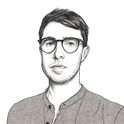For an artist known for his paintings of ethereal surgeons, mutilated faces, slabs of butcher’s meat and bloodied or otherwise disfigured people, Ken Currie possesses an alarmingly cheerful demeanour. I’m surprised to find that this sharply dressed man in a black zip-up pullover and a white mandarin-collar shirt is the same person who—according to his recently published studio journals—once pondered that “Nature can be brutally, stomach churningly hideous”.
True to expectations, however, we’ve barely taken our seats in the library of the Scottish National Portrait Gallery before Currie is pointing to a glass display of death masks close by. “See that emaciated one on the bottom row?” he says. “That’s the ‘Unknown Man’ from centuries ago. I wanted to put him in my portrait of Sue Black, looking back at her, but it got too complicated.”
In the finished portrait of Black—the forensic anthropologist who played a crucial role identifying the victims of war crimes in Kosovo—the man in question has been turned into an ominous cadaver covered by a green sheet. Black looms over the cadaver, looking straight at us with bloodshot eyes. The title of the work remains Unknown Man. Recently acquired from Flowers Gallery, it sits just a few rooms away from us.
Currie’s path could have been very different. His entry into art wasn’t from traipsing about galleries like this one—he looks at me somewhat wryly at the suggestion—but through prog rock and sci-fi, “the way a lot of other kids from my background got into art.” His father, a welder, would have preferred his son to follow him into engineering. But Currie “wasn’t very academically gifted,” he says, and so instead he opted for the “anarchic” Glasgow School of Art.
His earliest work, in the 1980s, was heavily political. As a student with “typical Scottish leftist views” who was involved in the Communist party, he painted giant murals showcasing the glory of steelworkers and shipbuilders. After the fall of the Berlin Wall, he became less at ease with this overly didactic approach—“it’s not for me to proselytise”—and turned to more philosophical concerns, many of which hover close to death.
“I don’t really think my work is about death,” he counters. “It’s mortality that interests me, the fact that we are capable of dying… It’s the fact that we are mortal, and the implications that has for the way we live our lives.” Is that why he is so often drawn to portraiture? “One of the great things about portraiture is that these people have been painted because they’re ‘pillars of society’,” Currie says. “But the feeling I get when I look at them is that they are transient creatures... They’ll go the same way as all the criminals and all the other people they’ve spent their whole lives trying to avoid.”
It’s only as we make to leave the library that I realise somebody has been watching us.
“I just wanted to say it has been an enormous privilege invigilating your work,” says a gallery attendant. “I have experienced some of the most incredible responses from the public.” She recalls one woman who burst into tears before Currie’s portrait of Black; a priest declaring he will write a sermon about her; and one man who screamed “Holy fuck!” the moment he stepped in the room.
“That wasn’t planned by the way,” Currie says, smiling like a big kid, as we continue down the stairs.
After such a glowing endorsement, I have to go see the works for myself.
Leaving Currie to rejoin his family, I head over to the room where Unknown Man and another of his works, Three Oncologists, are hanging. As I stare up into Black’s bloodshot eyes, I remember one of Currie’s journal entries, about the time she invited him to the anatomy centre at the University of Dundee. “Sue Black asked me to hold the hand of the cadaver. It was supple, cold, with a slight greasiness. It reminded me of handling a chicken prior to cooking.” Holy fuck, indeed.













